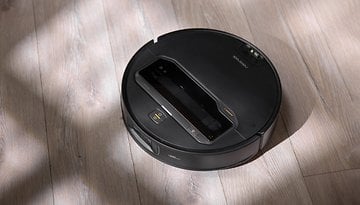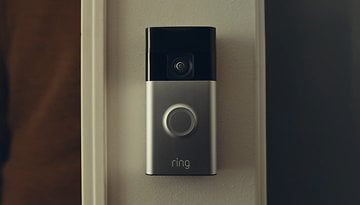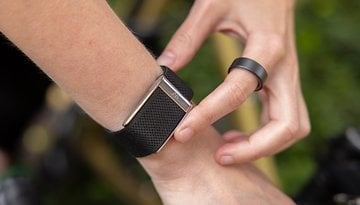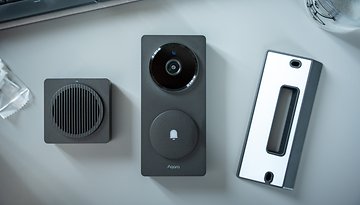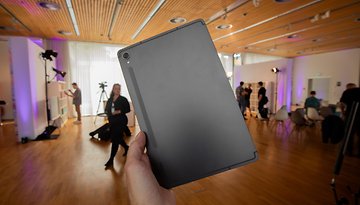Conrad Connect connects smart homes devices in the cloud


On the wild smart home frontier, it’s difficult to account for the vast variety of available devices. In our second article on networking IoT devices from different manufacturers, we look at Conrad Connect. The subsidiary of the German electronics retailer is developing a web service that creates a free cloud-based network between the web services of your devices and enables complex commands.
After we recently reported about Athom Homey and described to you how smart home devices from different manufacturers talk to each other with only one bridge and completely offline with the help of special hardware, we now head into the clouds. Conrad Connect is a cloud solution dedicated to the same issue. Compared to the offline alternatives, this offers some disadvantages, but also some sensible advantages.
Bridges upon bridges
Most smart home equipment manufacturers use a wireless standard for their Internet of Things (IoT) devices that your router still doesn’t support. So a radio module, a so-called bridge needs to be connected between the router and your smart home device. This is the only way to get the commands from your smartphone via your WiFi to the router. From there, the commands go to the bridge and then to the individual IoT devices.
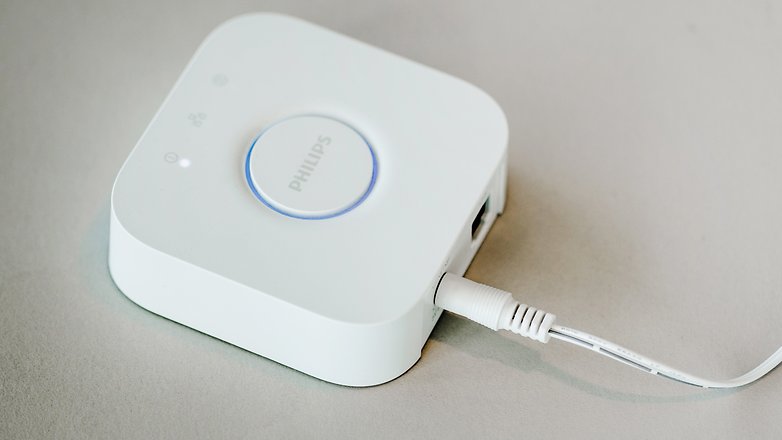
Clever observers in the industry and some engineers quickly recognized the problems that this entailed:
- Customer will soon have many bridges hanging on their routers.
- Brands’ devices will not be able to communicate with one another.
The alternative: multi-bridges from third parties
Since even if devices from two manufacturers are both set to Zigbee, it doesn’t mean that one manufacturer’s bridge controls the devices of the other. Such headaches will be solved by third parties using their own bridges, such as Amazon Echo Plus, QIVICON Home Base, wibutler, COQON Qbox Basic, Athom Homey, or some others.
However, this approach has its pitfalls in some cases. Firstly, many of these third-party bridges are only compatible with a fraction of the available IoT hardware, so it may be necessary to use several bridges in parallel. On the other hand, the connected IoT devices may not be supplied with software updates and therefore become a potential security risk for your networked home.

Conrad Connect welcomes diversity
If you’re not afraid of connecting a number of bridges, you’re probably better off with a service like Conrad Connect. Conrad Connect relies on a smart home concept that takes place completely online. Many IoT device manufacturers offer web services in addition to their bridges. These web services often provide an interface for your own apps, web interfaces or third-party apps. And this is where Conrad Connect comes in.
“Conrad Connect is theoretically compatible with all cloud services that can be assessed via a REST interface,” explains Giorgi Jashiashvili, who heads marketing at Conrad Connect’s Berlin headquarters. Partners register via the platform and there are already quite a few, including...
Amazon Echo, Ccontrol, Devolo, Dio, Easysmarthome, Egardia, Fitbit, Foobot, Fresh-Energy, Garmin, Google Home, GreenIQ, Home Connect, Honeywell, Innogy, Jawbone, lametric, LIFX, linemetrics, Logitech, Mediola, Mobile Alerts, myStrom, Nest, Netatmo, Nokia, Osram, Philips Hue, Polar, Raspberry Pi, Relayr, Smappee, Somfy, Spotcam, Sygonix, Tado, Tapkey, Telldus, Tukuoro, WiZ, and Zipato.
The win-win situation is obvious: Conrad Connect displays the products on the platform and immediately equips them with shop links leading to their parent company Conrad Elektronik. Of course, Conrad Connect users prefer to buy devices, and there also Conrad Connect devices.
Projects, recipes and an experienced community
Registration and the use of Conrad Connect is completely free. Jashiashvili explained to me that a Freemium plans would be conceivable in the long-term, but isn’t planned for the time being. Several users have already done so and have diligently created projects.
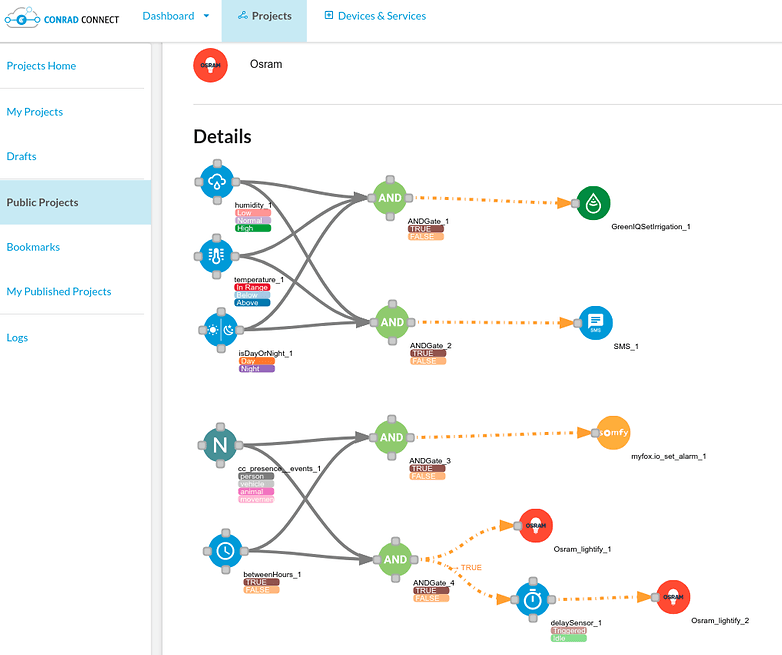
Projects are logical concatenations of several events in your smart household. The elements can be of different natures:
- Compatible sensors, such as the CO2 sensor in the Netatmo
- Values of online services such as Weather Underground
- A certain time of day
- 5,000 steps on your Garmin tracker
- Sending an SMS
- An Alexa or Google Assistant voice command
- A NAND gate or a logical operator
- In IFTTT recipe
- A light or dimmer
- A smart lock
In addition, IFTTT formulas can be integrated and SMS messages can be sent. The whole system looks strikingly similar to the flows in the Atom Homey. The difference here, however, likes in the type of networking of the individual actuators. This is because Conrad Connect operates completely in the cloud, i.e. on online servers instead of a physical box in your house.
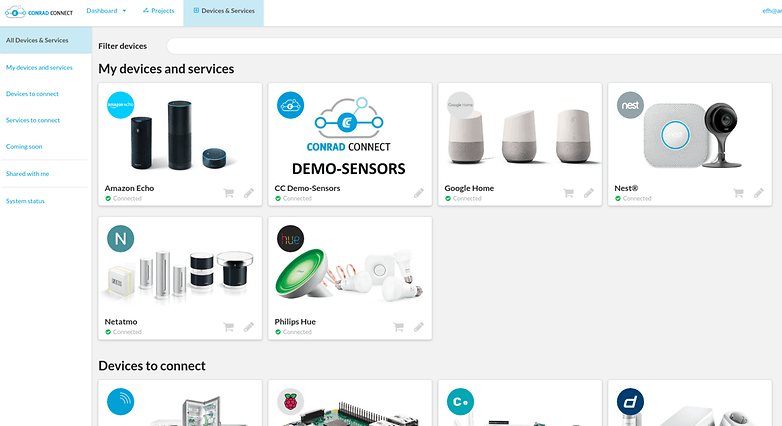
How Conrad Connect creates trust
During initial setup, your Conrad Connect allows access to all your smart home equipment. This can be done securely via OAuth, i.e. without Conrad Connect seeing the passwords of your respective IoT provider. The only questionable thing in the privacy policy would be due to third parties such as Google, Facebook or AddThis; Conrad Connect itself hardly collects any data about you and allegedly does not share it with anyone.
Conrad Connect: A group of visionaries
In the long run, Conrad Connect might have bet on the right horse. If router manufacturers increasingly install antennas for the radio standards used in the IoT range and can address Zigbee bulbs and Z-Wave motion detectors even without a bridge thanks to improved standardization, the above-mentioned hardware approaches will become obsolete.
Conrad Connect, on the other hand, will already have established a platform that will also be relevant in the post-bridge era. It does, however, remain to be seen whether it will still be offered free of charge or whether the time will come when they’ll start charging for the service.

